Enable College - CHCECE001: Cultural Competence Homework Assignment
VerifiedAdded on 2023/01/18
|41
|4840
|75
Homework Assignment
AI Summary
This assessment for CHCECE001, focused on developing cultural competence, covers a range of topics relevant to childcare professionals. The assignment addresses key concepts such as reflecting on cultural identity, understanding values, beliefs, and attitudes, and the influence of the environment on cultural identity. It explores the importance of cultural competency for educators, factors contributing to cultural identity, and the significance of reflective practice. The assessment also includes examples of barriers to cultural harmony and strategies to overcome them, ways to gather information about children, and the importance of collecting information about children's needs, interests, and cultural practices. Furthermore, the assignment requires research on Aboriginal and Torres Strait Islander history, specifically focusing on colonization. The assessment aims to evaluate the student's understanding of cultural competence and its practical application in early childhood education settings, referencing relevant frameworks and standards like NQF and EYLF.

Assessment for CHCECE001
Fill in all details & attach to the front of your completed
assignment.
Deliver to Enable College, or mail to Level 3, 31 Franklin St, Adelaide
SA 5000.
No responsibility will be taken by Enable College for loss or damage during
transit
All answers must be written in ink and clearly legible or typed using font size
11 or 12.
UNIT: 2726610544027745465.docxCHCECE001 Develop cultural competence.
NAME:
ADDRESS:
POSTCODE: TRAINER’S NAME:
Academic Pass Not Yet Competent/Please Resubmit
Assessor’s overall comment:
STUDENT DECLARATION
This assignment is all my own work, no part has been written for me by another person.
No part has been copied from another person’s work except where referenced (including books, journals
and the internet).
I have a copy of this assignment which I can produce if the original is lost or damaged.
I fully understand what I am required to do to complete these assessment tasks successfully
Signature: : Date:
Fill in all details & attach to the front of your completed
assignment.
Deliver to Enable College, or mail to Level 3, 31 Franklin St, Adelaide
SA 5000.
No responsibility will be taken by Enable College for loss or damage during
transit
All answers must be written in ink and clearly legible or typed using font size
11 or 12.
UNIT: 2726610544027745465.docxCHCECE001 Develop cultural competence.
NAME:
ADDRESS:
POSTCODE: TRAINER’S NAME:
Academic Pass Not Yet Competent/Please Resubmit
Assessor’s overall comment:
STUDENT DECLARATION
This assignment is all my own work, no part has been written for me by another person.
No part has been copied from another person’s work except where referenced (including books, journals
and the internet).
I have a copy of this assignment which I can produce if the original is lost or damaged.
I fully understand what I am required to do to complete these assessment tasks successfully
Signature: : Date:
Paraphrase This Document
Need a fresh take? Get an instant paraphrase of this document with our AI Paraphraser

Assessor’s name & signature:
Date:
ASSESSMENT INSTRUCTIONS FOR THE LEARNER
Date:
ASSESSMENT INSTRUCTIONS FOR THE LEARNER
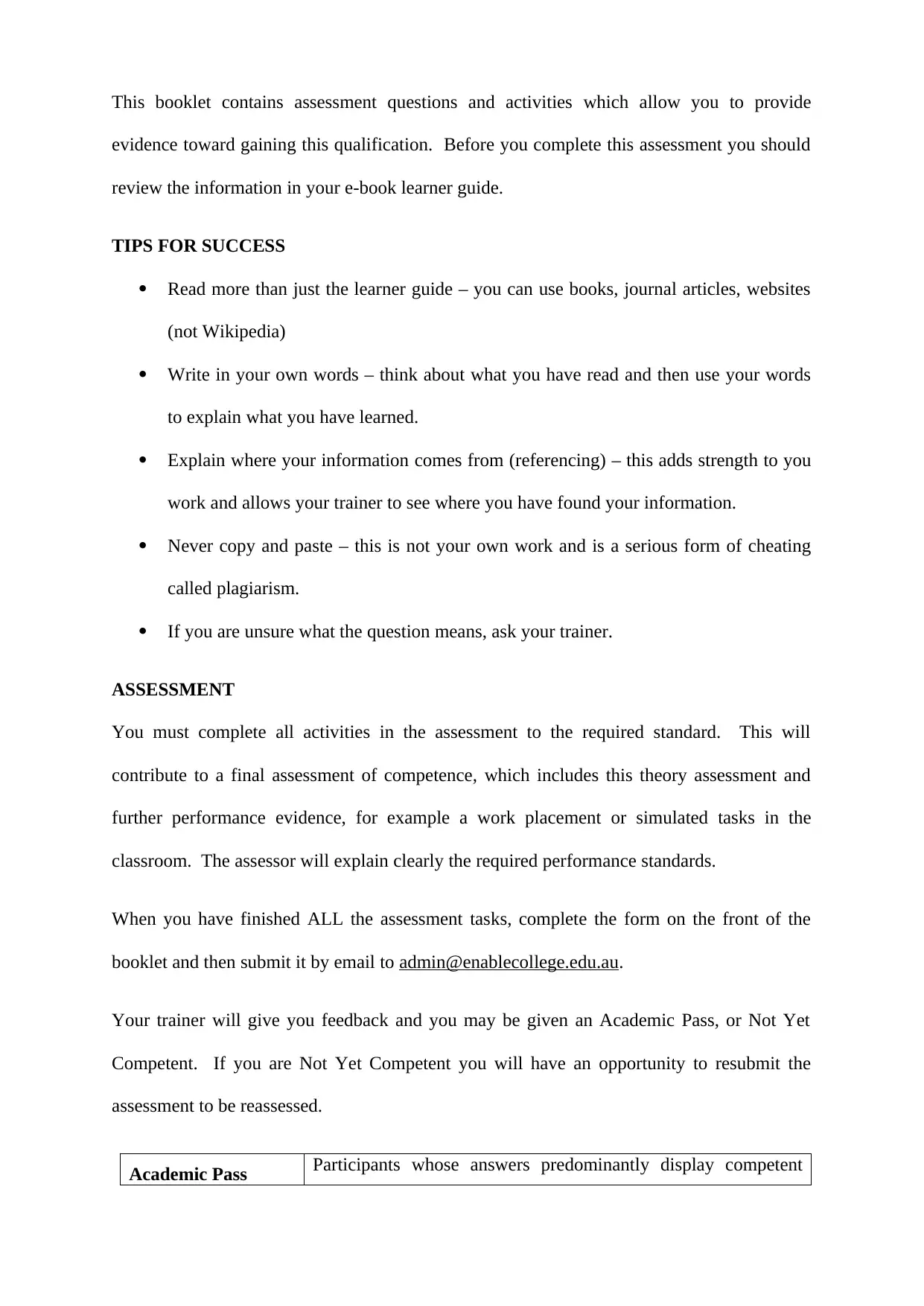
This booklet contains assessment questions and activities which allow you to provide
evidence toward gaining this qualification. Before you complete this assessment you should
review the information in your e-book learner guide.
TIPS FOR SUCCESS
Read more than just the learner guide – you can use books, journal articles, websites
(not Wikipedia)
Write in your own words – think about what you have read and then use your words
to explain what you have learned.
Explain where your information comes from (referencing) – this adds strength to you
work and allows your trainer to see where you have found your information.
Never copy and paste – this is not your own work and is a serious form of cheating
called plagiarism.
If you are unsure what the question means, ask your trainer.
ASSESSMENT
You must complete all activities in the assessment to the required standard. This will
contribute to a final assessment of competence, which includes this theory assessment and
further performance evidence, for example a work placement or simulated tasks in the
classroom. The assessor will explain clearly the required performance standards.
When you have finished ALL the assessment tasks, complete the form on the front of the
booklet and then submit it by email to admin@enablecollege.edu.au.
Your trainer will give you feedback and you may be given an Academic Pass, or Not Yet
Competent. If you are Not Yet Competent you will have an opportunity to resubmit the
assessment to be reassessed.
Academic Pass Participants whose answers predominantly display competent
evidence toward gaining this qualification. Before you complete this assessment you should
review the information in your e-book learner guide.
TIPS FOR SUCCESS
Read more than just the learner guide – you can use books, journal articles, websites
(not Wikipedia)
Write in your own words – think about what you have read and then use your words
to explain what you have learned.
Explain where your information comes from (referencing) – this adds strength to you
work and allows your trainer to see where you have found your information.
Never copy and paste – this is not your own work and is a serious form of cheating
called plagiarism.
If you are unsure what the question means, ask your trainer.
ASSESSMENT
You must complete all activities in the assessment to the required standard. This will
contribute to a final assessment of competence, which includes this theory assessment and
further performance evidence, for example a work placement or simulated tasks in the
classroom. The assessor will explain clearly the required performance standards.
When you have finished ALL the assessment tasks, complete the form on the front of the
booklet and then submit it by email to admin@enablecollege.edu.au.
Your trainer will give you feedback and you may be given an Academic Pass, or Not Yet
Competent. If you are Not Yet Competent you will have an opportunity to resubmit the
assessment to be reassessed.
Academic Pass Participants whose answers predominantly display competent
⊘ This is a preview!⊘
Do you want full access?
Subscribe today to unlock all pages.

Trusted by 1+ million students worldwide
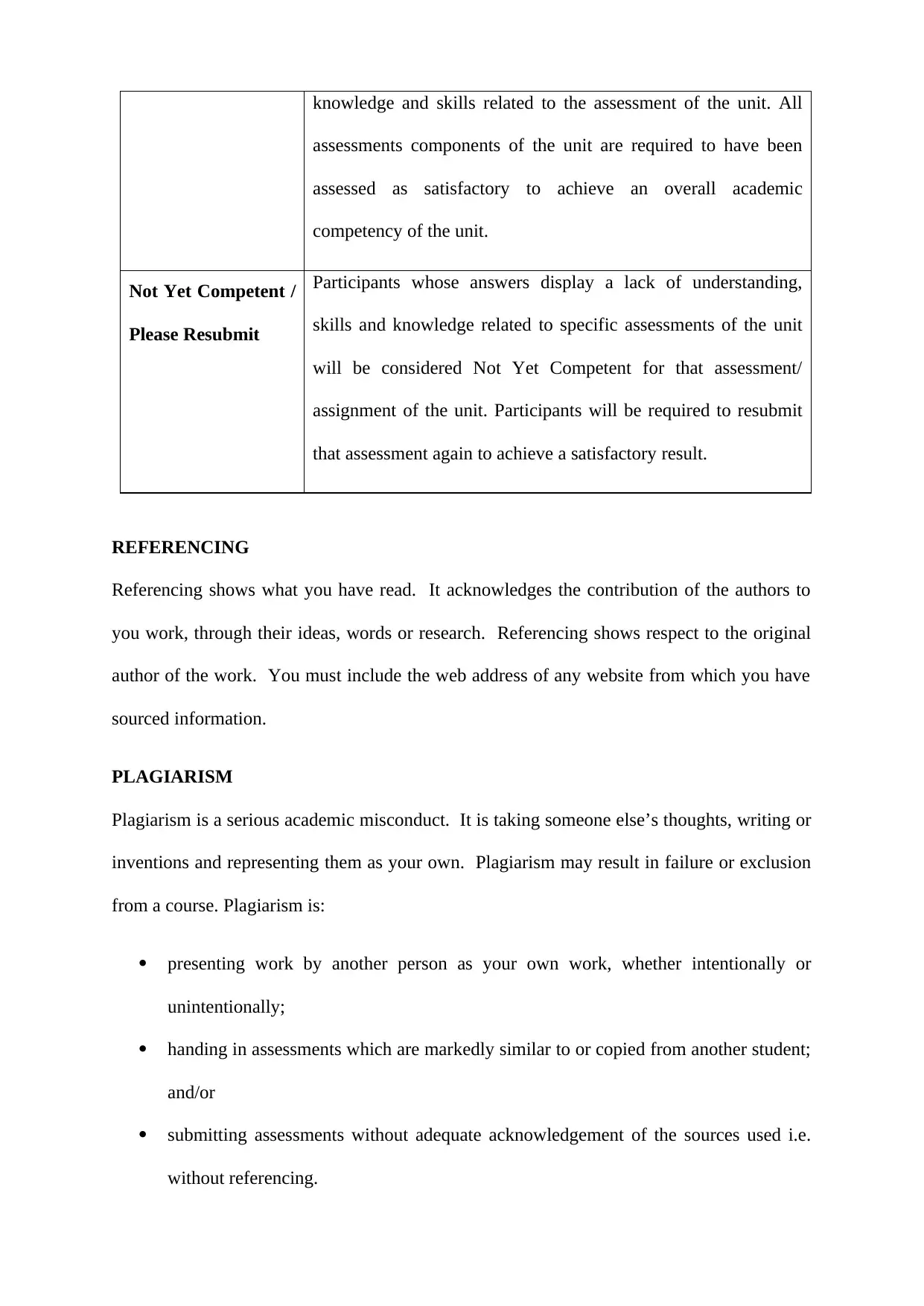
knowledge and skills related to the assessment of the unit. All
assessments components of the unit are required to have been
assessed as satisfactory to achieve an overall academic
competency of the unit.
Not Yet Competent /
Please Resubmit
Participants whose answers display a lack of understanding,
skills and knowledge related to specific assessments of the unit
will be considered Not Yet Competent for that assessment/
assignment of the unit. Participants will be required to resubmit
that assessment again to achieve a satisfactory result.
REFERENCING
Referencing shows what you have read. It acknowledges the contribution of the authors to
you work, through their ideas, words or research. Referencing shows respect to the original
author of the work. You must include the web address of any website from which you have
sourced information.
PLAGIARISM
Plagiarism is a serious academic misconduct. It is taking someone else’s thoughts, writing or
inventions and representing them as your own. Plagiarism may result in failure or exclusion
from a course. Plagiarism is:
presenting work by another person as your own work, whether intentionally or
unintentionally;
handing in assessments which are markedly similar to or copied from another student;
and/or
submitting assessments without adequate acknowledgement of the sources used i.e.
without referencing.
assessments components of the unit are required to have been
assessed as satisfactory to achieve an overall academic
competency of the unit.
Not Yet Competent /
Please Resubmit
Participants whose answers display a lack of understanding,
skills and knowledge related to specific assessments of the unit
will be considered Not Yet Competent for that assessment/
assignment of the unit. Participants will be required to resubmit
that assessment again to achieve a satisfactory result.
REFERENCING
Referencing shows what you have read. It acknowledges the contribution of the authors to
you work, through their ideas, words or research. Referencing shows respect to the original
author of the work. You must include the web address of any website from which you have
sourced information.
PLAGIARISM
Plagiarism is a serious academic misconduct. It is taking someone else’s thoughts, writing or
inventions and representing them as your own. Plagiarism may result in failure or exclusion
from a course. Plagiarism is:
presenting work by another person as your own work, whether intentionally or
unintentionally;
handing in assessments which are markedly similar to or copied from another student;
and/or
submitting assessments without adequate acknowledgement of the sources used i.e.
without referencing.
Paraphrase This Document
Need a fresh take? Get an instant paraphrase of this document with our AI Paraphraser
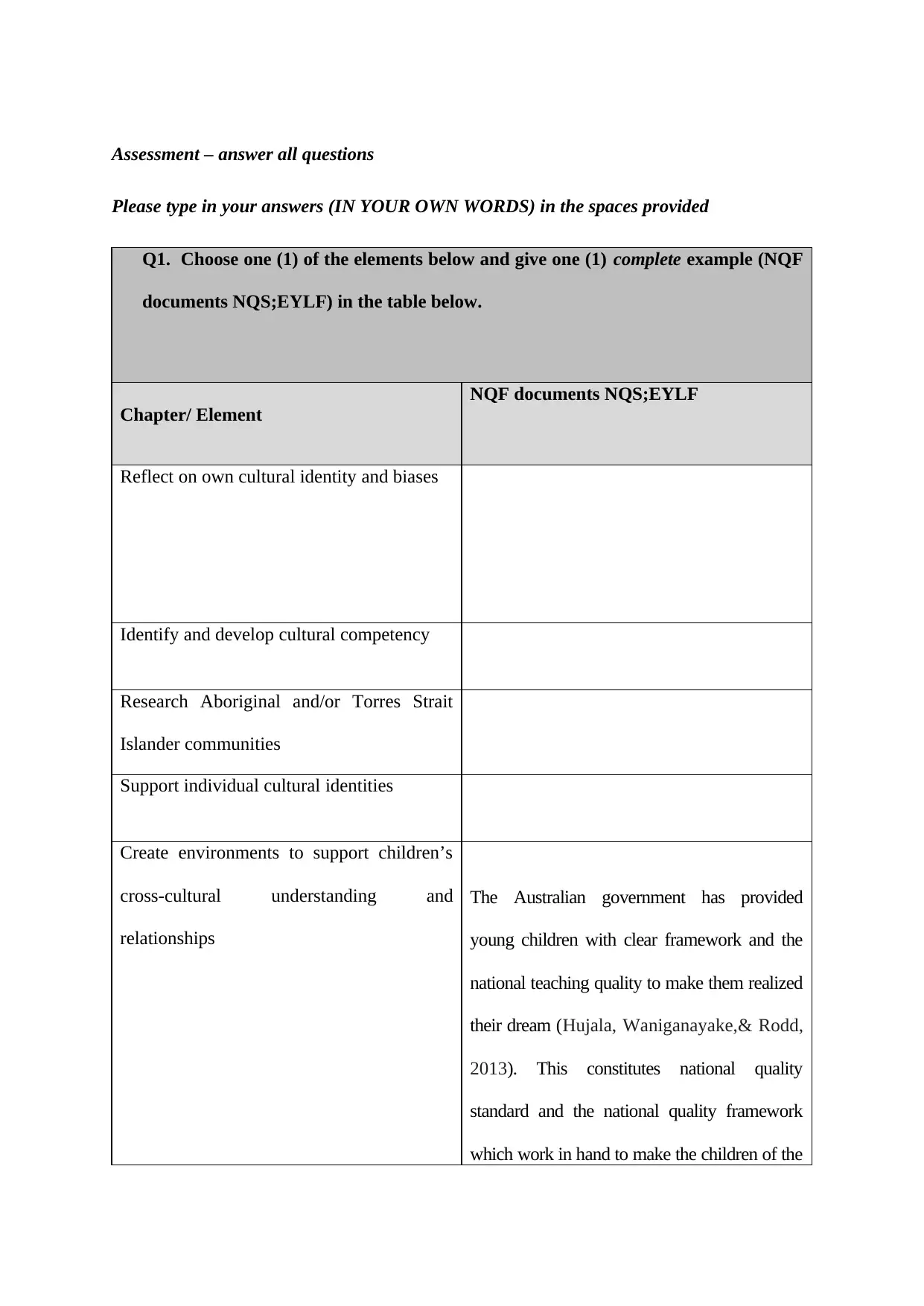
Assessment – answer all questions
Please type in your answers (IN YOUR OWN WORDS) in the spaces provided
Q1. Choose one (1) of the elements below and give one (1) complete example (NQF
documents NQS;EYLF) in the table below.
Chapter/ Element
NQF documents NQS;EYLF
Reflect on own cultural identity and biases
Identify and develop cultural competency
Research Aboriginal and/or Torres Strait
Islander communities
Support individual cultural identities
Create environments to support children’s
cross-cultural understanding and
relationships
The Australian government has provided
young children with clear framework and the
national teaching quality to make them realized
their dream (Hujala, Waniganayake,& Rodd,
2013). This constitutes national quality
standard and the national quality framework
which work in hand to make the children of the
Please type in your answers (IN YOUR OWN WORDS) in the spaces provided
Q1. Choose one (1) of the elements below and give one (1) complete example (NQF
documents NQS;EYLF) in the table below.
Chapter/ Element
NQF documents NQS;EYLF
Reflect on own cultural identity and biases
Identify and develop cultural competency
Research Aboriginal and/or Torres Strait
Islander communities
Support individual cultural identities
Create environments to support children’s
cross-cultural understanding and
relationships
The Australian government has provided
young children with clear framework and the
national teaching quality to make them realized
their dream (Hujala, Waniganayake,& Rodd,
2013). This constitutes national quality
standard and the national quality framework
which work in hand to make the children of the
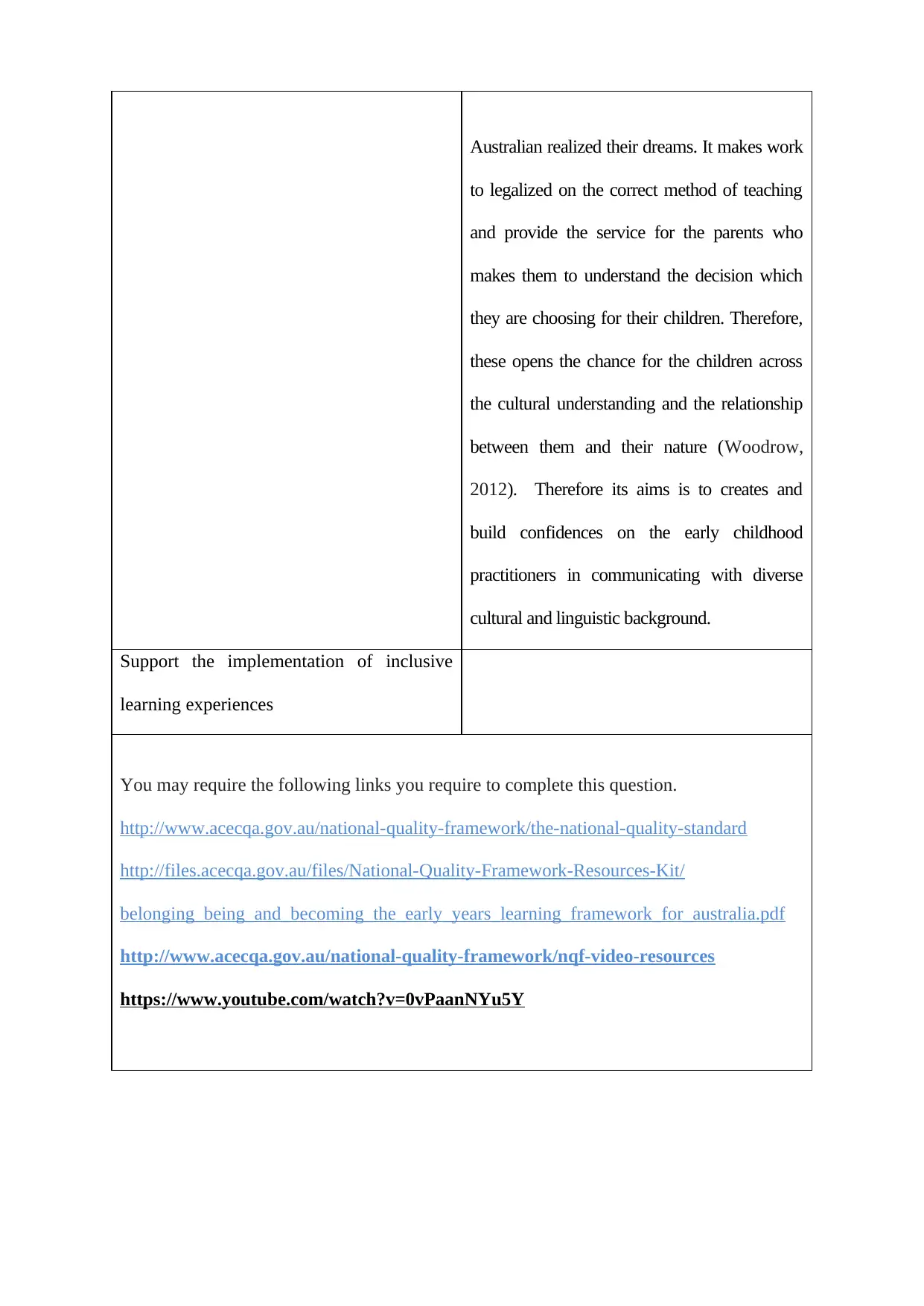
Australian realized their dreams. It makes work
to legalized on the correct method of teaching
and provide the service for the parents who
makes them to understand the decision which
they are choosing for their children. Therefore,
these opens the chance for the children across
the cultural understanding and the relationship
between them and their nature (Woodrow,
2012). Therefore its aims is to creates and
build confidences on the early childhood
practitioners in communicating with diverse
cultural and linguistic background.
Support the implementation of inclusive
learning experiences
You may require the following links you require to complete this question.
http://www.acecqa.gov.au/national-quality-framework/the-national-quality-standard
http://files.acecqa.gov.au/files/National-Quality-Framework-Resources-Kit/
belonging_being_and_becoming_the_early_years_learning_framework_for_australia.pdf
http://www.acecqa.gov.au/national-quality-framework/nqf-video-resources
https://www.youtube.com/watch?v=0vPaanNYu5Y
to legalized on the correct method of teaching
and provide the service for the parents who
makes them to understand the decision which
they are choosing for their children. Therefore,
these opens the chance for the children across
the cultural understanding and the relationship
between them and their nature (Woodrow,
2012). Therefore its aims is to creates and
build confidences on the early childhood
practitioners in communicating with diverse
cultural and linguistic background.
Support the implementation of inclusive
learning experiences
You may require the following links you require to complete this question.
http://www.acecqa.gov.au/national-quality-framework/the-national-quality-standard
http://files.acecqa.gov.au/files/National-Quality-Framework-Resources-Kit/
belonging_being_and_becoming_the_early_years_learning_framework_for_australia.pdf
http://www.acecqa.gov.au/national-quality-framework/nqf-video-resources
https://www.youtube.com/watch?v=0vPaanNYu5Y
⊘ This is a preview!⊘
Do you want full access?
Subscribe today to unlock all pages.

Trusted by 1+ million students worldwide

Assessors comment:
Paraphrase This Document
Need a fresh take? Get an instant paraphrase of this document with our AI Paraphraser

Q 2. What do you understand by the following terms:
a) Value
Value this is the desirable quality, which has positive and negative impacts toward
other needs. Therefore is termed as the degree of the importance of the something to
individuals or the people as well as the other things. Based on the aboriginal islander
individual, their mission was just to live in agreement. Therefore, their life was rested
on the value.
b) Belief
This is desirable trust or faith someone has got about something of the particular
interests. Is characterised by the staunched faith individuals have a bout the
God or about the relation they had. This is illustrated within the aboriginal
society of the Australia.
c) Attitude
This is literally means the position of the individuals towards desirable’s
things. It characterised by the positive or negative depending with situation of
a given states. With references to aboriginal society in regard to attitude,
there was thus no notion of progress and no room for competing dogmas or
the rebellion against status quo.
a) Value
Value this is the desirable quality, which has positive and negative impacts toward
other needs. Therefore is termed as the degree of the importance of the something to
individuals or the people as well as the other things. Based on the aboriginal islander
individual, their mission was just to live in agreement. Therefore, their life was rested
on the value.
b) Belief
This is desirable trust or faith someone has got about something of the particular
interests. Is characterised by the staunched faith individuals have a bout the
God or about the relation they had. This is illustrated within the aboriginal
society of the Australia.
c) Attitude
This is literally means the position of the individuals towards desirable’s
things. It characterised by the positive or negative depending with situation of
a given states. With references to aboriginal society in regard to attitude,
there was thus no notion of progress and no room for competing dogmas or
the rebellion against status quo.

⊘ This is a preview!⊘
Do you want full access?
Subscribe today to unlock all pages.

Trusted by 1+ million students worldwide
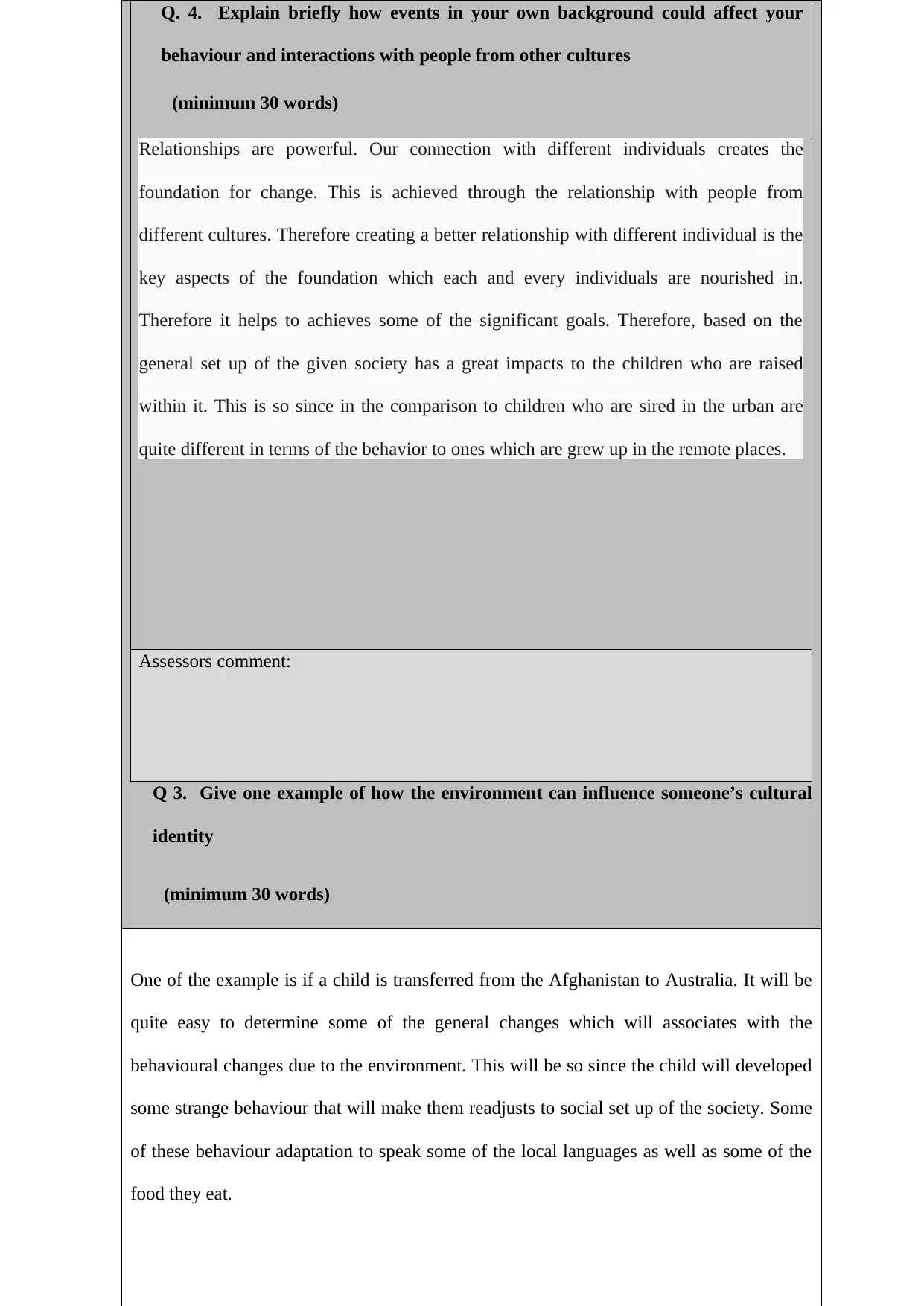
Q. 4. Explain briefly how events in your own background could affect your
behaviour and interactions with people from other cultures
(minimum 30 words)
Relationships are powerful. Our connection with different individuals creates the
foundation for change. This is achieved through the relationship with people from
different cultures. Therefore creating a better relationship with different individual is the
key aspects of the foundation which each and every individuals are nourished in.
Therefore it helps to achieves some of the significant goals. Therefore, based on the
general set up of the given society has a great impacts to the children who are raised
within it. This is so since in the comparison to children who are sired in the urban are
quite different in terms of the behavior to ones which are grew up in the remote places.
Assessors comment:
Q 3. Give one example of how the environment can influence someone’s cultural
identity
(minimum 30 words)
One of the example is if a child is transferred from the Afghanistan to Australia. It will be
quite easy to determine some of the general changes which will associates with the
behavioural changes due to the environment. This will be so since the child will developed
some strange behaviour that will make them readjusts to social set up of the society. Some
of these behaviour adaptation to speak some of the local languages as well as some of the
food they eat.
behaviour and interactions with people from other cultures
(minimum 30 words)
Relationships are powerful. Our connection with different individuals creates the
foundation for change. This is achieved through the relationship with people from
different cultures. Therefore creating a better relationship with different individual is the
key aspects of the foundation which each and every individuals are nourished in.
Therefore it helps to achieves some of the significant goals. Therefore, based on the
general set up of the given society has a great impacts to the children who are raised
within it. This is so since in the comparison to children who are sired in the urban are
quite different in terms of the behavior to ones which are grew up in the remote places.
Assessors comment:
Q 3. Give one example of how the environment can influence someone’s cultural
identity
(minimum 30 words)
One of the example is if a child is transferred from the Afghanistan to Australia. It will be
quite easy to determine some of the general changes which will associates with the
behavioural changes due to the environment. This will be so since the child will developed
some strange behaviour that will make them readjusts to social set up of the society. Some
of these behaviour adaptation to speak some of the local languages as well as some of the
food they eat.
Paraphrase This Document
Need a fresh take? Get an instant paraphrase of this document with our AI Paraphraser
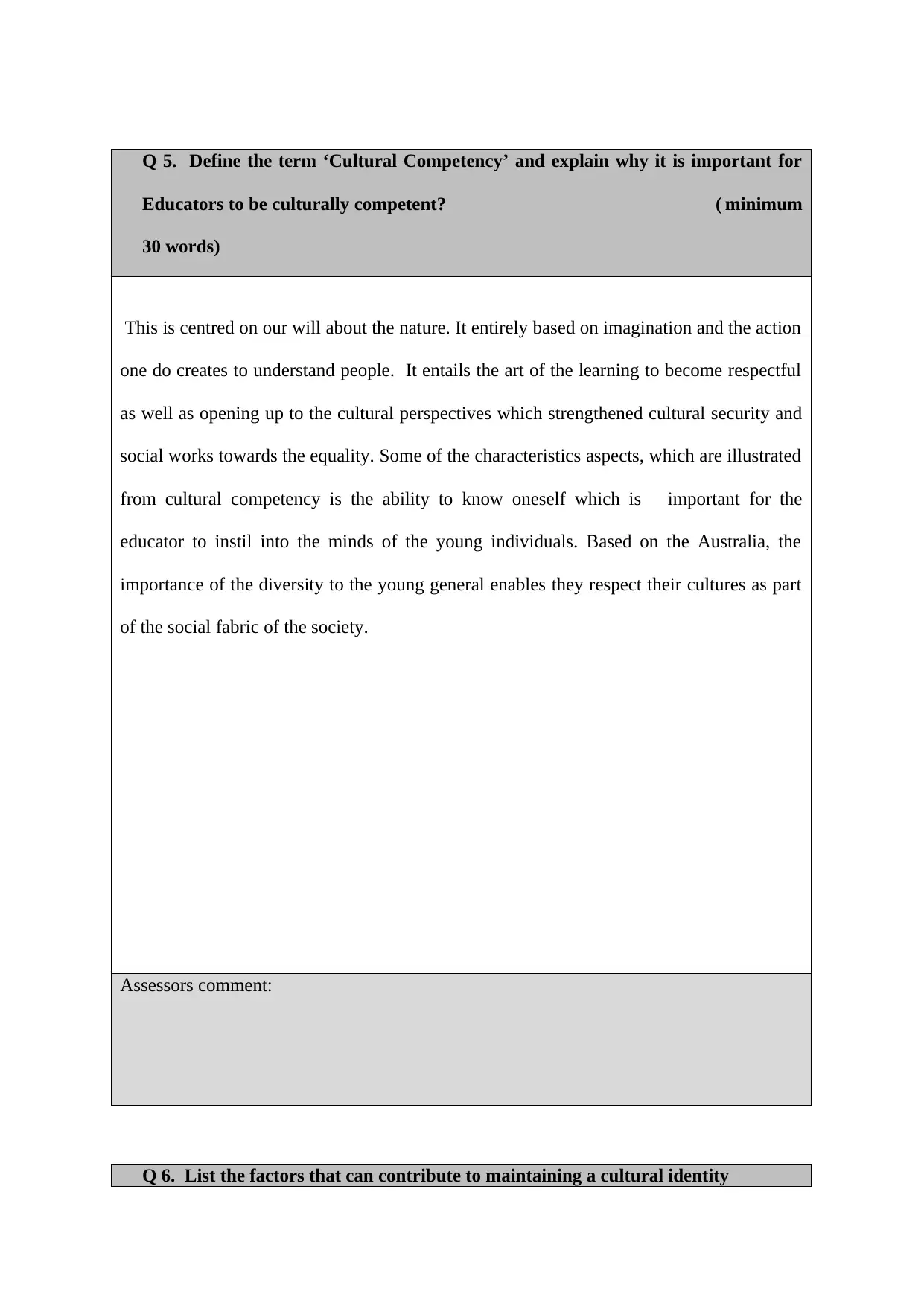
Q 5. Define the term ‘Cultural Competency’ and explain why it is important for
Educators to be culturally competent? ( minimum
30 words)
This is centred on our will about the nature. It entirely based on imagination and the action
one do creates to understand people. It entails the art of the learning to become respectful
as well as opening up to the cultural perspectives which strengthened cultural security and
social works towards the equality. Some of the characteristics aspects, which are illustrated
from cultural competency is the ability to know oneself which is important for the
educator to instil into the minds of the young individuals. Based on the Australia, the
importance of the diversity to the young general enables they respect their cultures as part
of the social fabric of the society.
Assessors comment:
Q 6. List the factors that can contribute to maintaining a cultural identity
Educators to be culturally competent? ( minimum
30 words)
This is centred on our will about the nature. It entirely based on imagination and the action
one do creates to understand people. It entails the art of the learning to become respectful
as well as opening up to the cultural perspectives which strengthened cultural security and
social works towards the equality. Some of the characteristics aspects, which are illustrated
from cultural competency is the ability to know oneself which is important for the
educator to instil into the minds of the young individuals. Based on the Australia, the
importance of the diversity to the young general enables they respect their cultures as part
of the social fabric of the society.
Assessors comment:
Q 6. List the factors that can contribute to maintaining a cultural identity
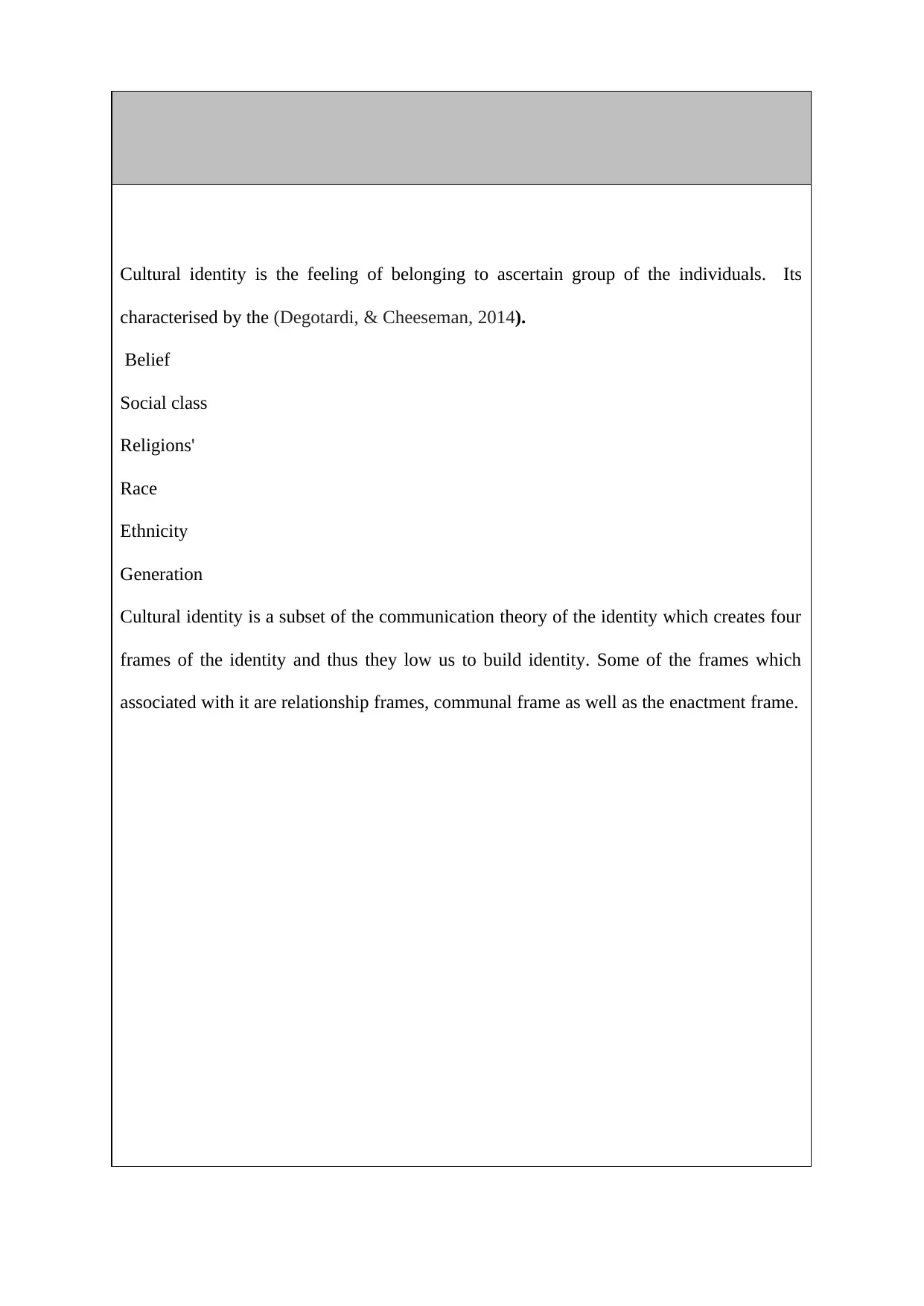
Cultural identity is the feeling of belonging to ascertain group of the individuals. Its
characterised by the (Degotardi, & Cheeseman, 2014).
Belief
Social class
Religions'
Race
Ethnicity
Generation
Cultural identity is a subset of the communication theory of the identity which creates four
frames of the identity and thus they low us to build identity. Some of the frames which
associated with it are relationship frames, communal frame as well as the enactment frame.
characterised by the (Degotardi, & Cheeseman, 2014).
Belief
Social class
Religions'
Race
Ethnicity
Generation
Cultural identity is a subset of the communication theory of the identity which creates four
frames of the identity and thus they low us to build identity. Some of the frames which
associated with it are relationship frames, communal frame as well as the enactment frame.
⊘ This is a preview!⊘
Do you want full access?
Subscribe today to unlock all pages.

Trusted by 1+ million students worldwide
1 out of 41
Related Documents
Your All-in-One AI-Powered Toolkit for Academic Success.
+13062052269
info@desklib.com
Available 24*7 on WhatsApp / Email
![[object Object]](/_next/static/media/star-bottom.7253800d.svg)
Unlock your academic potential
Copyright © 2020–2025 A2Z Services. All Rights Reserved. Developed and managed by ZUCOL.





